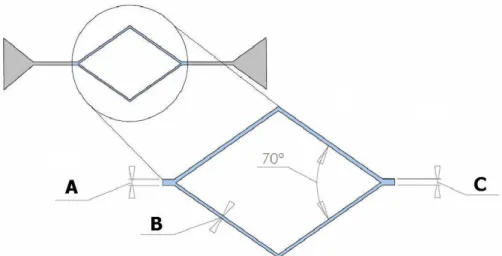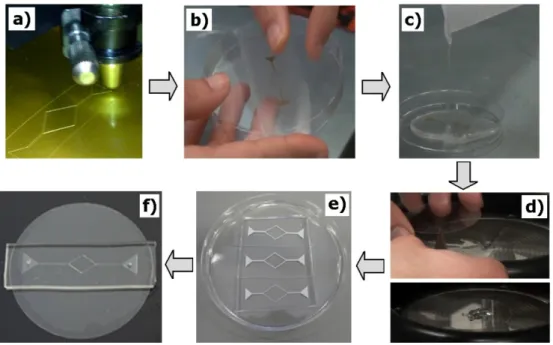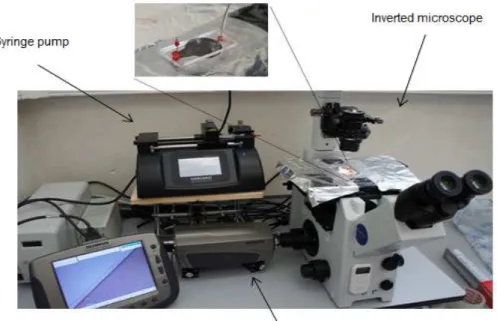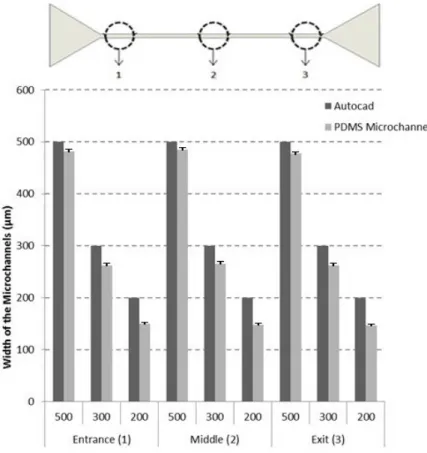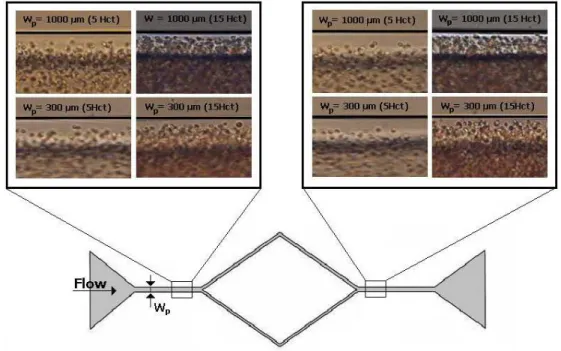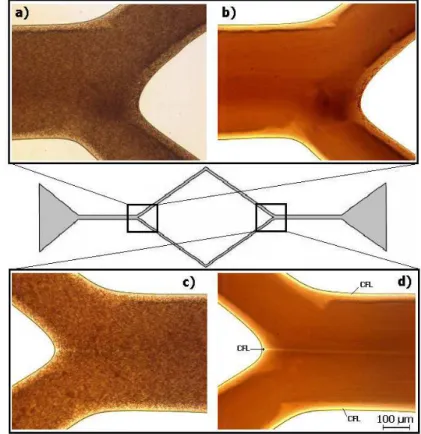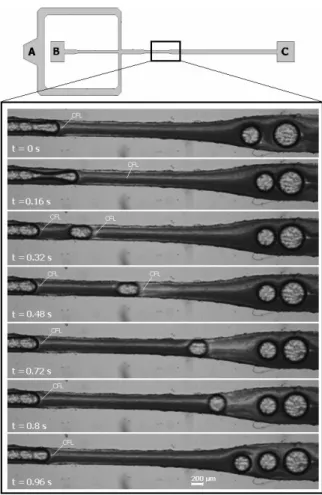micromachines
ISSN 2072-666X www.mdpi.com/journal/micromachines Article
A Rapid and Low-Cost Nonlithographic Method to Fabricate
Biomedical Microdevices for Blood Flow Analysis
Elmano Pinto 1,2, Vera Faustino 1, Raquel O. Rodrigues 1,3, Diana Pinho 1,2, Valdemar Garcia 1, João M. Miranda 2 and Rui Lima 1,2,4,*
1 School of Technology and Management (ESTiG), Polytechnic Institute of Bragança (IPB), Campus
de Santa Apolónia, 5300-253 Bragança, Portugal; E-Mails: elmanopinto@hotmail.com (E.P.); verafaustino@ipb.pt (V.F.); raquel.rodrigues@ipb.pt (R.O.R.); diana@ipb.pt (D.P.);
valdemar@ipb.pt (V.G.)
2 Transport Phenomena Research Center, Department of Chemical Engineering, Engineering Faculty,
University of Porto, Rua Dr. Roberto Frias, 4200-465 Porto, Portugal; E-Mail: jmiranda@fe.up.pt
3 Laboratory of Catalysis and Materials—Associate Laboratory LSRE/LCM, Engineering Faculty,
University of Porto, Rua Dr. Roberto Frias, 4200-465 Porto, Portugal
4 Department of Mechanical Engineering, Minho University, Campus de Azurém, 4800-058 Guimarães,
Portugal
* Author to whom correspondence should be addressed; E-Mail: ruimec@ipb.pt; Tel.: +351-253-510-220; Fax: +351-253-516-007.
Academic Editor: Cheng Luo
Received: 27 October 2014 / Accepted: 16 December 2014 / Published: 30 December 2014
and can perform massive amount of parallel operations. By integrating several steps into a single system, microfluidic devices allow performing rapid measurements in a single step and, consequently, they offer great potential to develop portable and point-of-care devices [3,5].
One of most popular and traditional methods to fabricate microfluidic devices is the soft lithography technique, with polydimethylsiloxane (PDMS) structures made from SU-8 molds [6–8]. The SU-8 molds are produced by photolithography. The main attraction of this technology is due, mainly, to its high-resolution capabilities, low material cost, gas permeability, and optical transparency [6]. However, the photolithographic production of molds usually requires a clean-room environment and specialized equipment that can be quite costly, and the process is time consuming. These drawbacks are currently slowing down development, especially in research institutions without specialized facilities to produce molds by photolithography. Access to rapid microfabrication methods is essential to improve development cycles and to test new chip designs and research ideas. Hence, it is crucial to develop simple, rapid, and low-cost nonlithographic techniques to fabricate microfluidic systems.
Nonlithographic techniques, also known as print-and-peel (PAP) [9], were first reported at the beginning of this century, using a xerographic process to fabricate molds for PDMS microfluidic microdevices [10]. Later on, Branham et al. [11] demonstrated the application of a laser jet printer to fabricate PDMS microdevices. A few years later, Bao et al. [12] used this PAP technique to perform capillary electrophoresis. Chen et al. [13] proposed the use of pre-stressed thermoplastic sheets, which shrink when heated, as a base material for low cost microfluidics. Bonyár et al. [14] demonstrated the ability of 3D rapid prototyping technology to produce functional microfluidic devices and molds for PDMS microchannels. Other low cost non-lithographic technologies were reviewed by Waldbaur et al. [15], including laser direct machining [16] and Inkjet 3D printing [17]. A PAP method, known as xurography, has shown to be an effective, novel, and rapid prototyping technique to fabricate microfluidic channels [18]. Xurography uniquely uses a cutting plotter machine and adhesive vinyl films to generate the master molds, or to directly fabricate the microchannels, and, consequently, does not involve any photolithographic processes. Recently, Sundberg et al. [19] demonstrated the application of this PAP approach to create microfluidic channels to perform DNA melting analysis. However, no work has been performed yet to test biomimetic separations.
and pathological state of the human body. Hence, there is an evident interest to develop microfluidic devices for the diagnosis of major diseases, such as cancer, diabetes mellitus, and cardiovascular disorders. The traditional method for creating the microfluidic devices is soft lithography, using molds obtained by photolithography. By using this fabrication technique Shevkoplyas et al. [24] developed a microdevice to isolate white blood cells (WBCs) from a blood sample by using the margination effect, whereas Hou et al. [25] have very recently proposed a biomimetic separation device to separate normal and malaria infected red blood cells (RBCs). Other researchers, such as Faivre et al. [26], Sollier et al. [27], and Pinho et al. [22], have demonstrated that the cell free layer (CFL) could be enhanced by using a microchannel containing a constriction followed by a sudden expansion to separate plasma from the whole in vitro blood.
Although the results are extremely encouraging, the high costs and time involved in the traditional photolithography process are currently slowing down the development and diffusion of biomimetic separation biochips among a large research and industrial community. Hence, there is a demand for low-cost and short fabrication time methods to produce microfluidic systems. Here, we introduce a low-cost nonlithographic technique, known as bioxurography, due to its fast fabrication time, independence from clean room facilities and low material and equipment cost, as an ideal solution to manufacture affordable microfluidic devices to work on the scales required to perform blood cell analysis in continuous flow.
2. Materials and Methods
2.1. Geometries of the Microchannels
The molds for the microfluidic devices tested in this study were fabricated using a xurography technique and consist of two main geometries: a microchannel with a diverging and converging bifurcation and a flow-focusing microfluidic device. Figures 1 and 2 show the geometries and main dimensions of the microfluidic devices tested in this study. For the first case (see Figure 1), the geometries were selected taking into account a previous study performed on the blood flow behavior through microchannels with bifurcations and confluences fabricated by a soft lithography technique [7]. Here, due to the limitation of the xurography technique, the minimum dimension of the microchannel width was around 150 µm. Hence, the parent microchannel had a minimum width of 300 µm and maximum width of 1000 µm whereas the two branches of the bifurcation and confluence correspond to 50% of parent channel width. Chips with three different channel dimensions were studied; with parent channel dimensions of 300, 500 and 1000 µm.
Figure 1. Schematic diagram of the microchannel geometry with a diverging and converging bifurcation where the width of channels A and C are 300, 500, or 1000 μm, and the widths of respective ramifications B are 150, 250, or 500 μm.
Figure 2. Schematic diagram of the microfluidic flow-focusing device geometry used to generate bubbles where continuous phase (in vitro blood) and dispersed phase (air) are introduced in A and B, respectively, and C is the outlet of mixture of both phases.
2.2. Fabrication of the Microfluidic Devices
The tested microchannels were fabricated by a xurography technique, which can be performed at low cost in a straightforward manner. Specifically, the fabrication process, which is outlined in Figure 3, was as follows:
(a) The microchannel geometries were drawn using a CAD software, and then the molds were cut by using a cutting plotter Jaguar II (GCC Innovation, Capelle aan den Ijssel, The Netherlands). (b) Adhesive paper was used to transfer and place the mold master inside the petri dish.
(c) The PDMS prepolymer was prepared by mixing a commercial prepolymer and a curing agent (10:1 ratio) and poured onto master mold in the petri dish and cured in an oven at 80 °C for 20 min. (d) The PDMS (20:1 ratio) was spin coated over a glass slide and cured in an oven at 80 °C for 20 min. (e) By using a blade, the microchannels were cut off and the inlet/outlet holes of the fluid were
done by using a fluid-dispensing tip.
Figure 3. Main steps of the fabrication procedure: (a) Cutting the CAD geometries in the vinyl paper by means of a cutting plotter; (b) transfer the mold to the petri dish using an adhesive; (c) pouring the polymer PDMS over the mold to obtain the microchannel; (d) spin coating a slide glass with PDMS; (e) remove the cured PDMS microchannel from the vinyl mold; (f) three-dimensional PDMS microchannel with the input/output ports sealed with the spin-coated glass slide.
2.3. Working Fluids
The working fluid used in the first tested device (see Figure 1) was ovine red blood cells suspended with dextran 40 (Dx40). In this study we have used a hematocrit (Hct) of 5% and 15%. For the case of the flow-focusing device, the working fluids were air and Dx40 containing about 10% Hct of ovine RBCs. Briefly, blood was collected from a healthy ovine; heparin was added in order to prevent coagulation. The RBCs were separated from bulk blood by centrifugation (2000 rpm for 15 min at 4 °C) and then the plasma and buffy coat were removed by aspiration. The RBCs were then washed twice with a physiological saline solution and diluted with Dx40 to make up the required RBC concentration. All blood samples were stored hermetically at 4 °C until the experiments were performed at a room temperature of approximately 20 °C.
2.4. Experimental Set-Up
Figure 4. Main experimental equipment used to control and visualize the flow in microchannels produced by xurography.
2.5. Image Analysis
A manual tracking plugin (MTrackJ) of the image analysis software ImageJ [29] was used to track individual RBC flowing around the boundary of the RBCs core (Point 2 in Figure 5). By using the MTrackJ plugin, the centroid of the selected RBC was automatically computed [30]. Besides, the nearest wall position was measured (Point 1 in Figure 5) so that the distance between the tracked RBCs and the wall can be calculated, which consequently draws the CFL thickness (Figure 5).
To visualize the CFL formation in the microchannels, the captured videos were converted to a sequence of static images (stack) and then, by using “Z project” function in ImageJ, it was possible to obtain a single image having a sum of all static images. In this image, the darker region indicates RBC core and brighter region indicates CFL.
3. Results and Discussion
3.1. Characteristics of the Microchannels
To evaluate the geometrical quality of the mold masters and correspondent microchannels, several microscopic images were obtained along a device with a simple geometry. Light micrographs of the PDMS microchannels, fabricated using the proposed technique are shown in Figure 6. It also shows a schematic representation of the sections where the microscopic images were taken.
Figure 6. Schematic representation of the microchannel geometry and location of the sections where the microscopic images were collected to evaluate the geometrical quality. From left to right we have: (1) entrance, (2) middle, and (3) exit.
The geometrical qualities of the PDMS microchannels were evaluated using ImageJ and the ranges of values measured for all sections along the microchannels are shown in Figures 7 and 8. Figure 7 shows the comparison between the AutoCAD projected values and actual width measurements of the PDMS microchannels and consequently from the vinyl master molds. Figure 8 shows the depth measurements of the PDMS microchannels at three different sections, i.e., entrance (1), middle (2), and exit (3).
Figure 7. Comparison between the values projected from AutoCAD and width measurements of the PDMS microchannels at three different sections: entrance (1), middle (2), and exit (3). The measurements are expressed as the mean ± standard deviation according to a t-test analysis at 95% confidence interval.
3.2. Cell-Free Layer (CFL) Measurements and Visualization
In addition to a tendency of the RBCs to undergo axial migration induced by the cells’ tank treading motion, high wall shear stress forces the RBCs to move towards the center of the vessel. As a result, there is a formation of CFL with extremely low concentration of cells along the walls of the microchannels. In straight microchannels, the CFL can be defined as the distance between the microchannel wall and the boundary region of the RBCs core. Although the formation of the CFL in vivo [31–33] has been of great interest over many years, little information is available about this phenomenon mainly due to the limitation of the measurement techniques. Recently, several researchers [7,22,34] have attempted to replicate this phenomenon in vitro using biomedical microdevices in order to better understand it and explore its potential as a new diagnostic tool. Here, we show the effect of the Hct and geometry of a microcahnnel fabricated by xurography on CFL formation (Figure 9).
Figure 10 shows the results for CFL thickness for a constant flow rate of 10 μL/min, of 5% Hct and 15% Hct in a microchannel with a diverging and converging bifurcation for a width of the parent channel (Wp) of 300, 500, and 1000 μm. Note that all the CFL measurements were executed where the CFL had a steady formation, i.e., at the regions where the CFL is parallel to the wall. The results show that the CFL thickness is not strongly affected by the bifurcation, whereas it decreases with increasing Hct. This latter result corroborates with the past results performed in both in vivo [31,33] and in vitro [34] experiments.
Figure 11 shows the visualization of in vitro blood with 15% Hct flowing in a microchannel with a bifurcation followed by a confluence. All original images were converted by means of the “Z project” function (ImageJ) to a single image having a sum of all static images. The qualitative results show clearly the formation of a CFL not only around the walls but also in the region immediately after the confluence.
Figure 10. CFL thickness measured in blood flows of 5% Hct and 15% Hct in a microchannel with a diverging and converging bifurcation for a width of the parent channel (Wp) of 300, 500, and 1000 μm. The flow rate was 10 μL/min.
Figure 11. Visualization of in vitro blood with 15% Hct flowing in a microchannel geometry with (a) diverging bifurcation (original image); (b) diverging bifurcation (the sum of all images); (c) converging bifurcation or confluence (original image), and (d) converging bifurcation or confluence (the sum of all images). The flow rate was 10 μL/min.
evidence that at width dimensions up to 500 μm there still is a formation of a CFL around the apex of the confluence. Hence, by using xurography it is possible to create an artificial CFL under appropriate hemodynamic and geometrical conditions, and as a result, to develop low cost microfluidic systems for biomedical applications, such as blood cell separation and analysis.
3.3. Bubbles Generation and Visualization
An air embolism is a pathological condition caused by bubbles trapped in a blood vessel [36,37]. During surgeries and other medical procedures, small amounts of air may get into the blood stream accidentally. Air bubbles may also be formed in the blood stream due to cavitation in prosthetic heart valves or during decompression after scuba diving activities [37]. When an air bubble flows through a blood vessel, it may block small arteries and stop blood supply to a certain area of the body. Although it could be fatal if a large amount of bubbles flows through blood arteries, there is not enough information about the amount of air bubbles, which might cause death. It is known that the rate of reabsorption of microbubbles may be accelerated by the injection in the blood stream of surfactants [38]. Hence, it is important to improve our understanding on the flow of bubbles in microchannels with dimensions similar to in vivo blood vessels. There is also a demand for biochips for the development of new strategies and new surfactant based drugs to treat air embolisms. The xurographic technique was, therefore, used to developed microfluidic systems capable of generating air bubbles moving through the microchannel (Figure 12).
known as Taylor bubbles, and spherical bubbles. First, bubbles with a slug shape are formed and keep their shape until they reach the 600 µm smooth expansion, where they acquired a circular shape. These slug bubbles flow through the microchannel, separated from each other by liquid slugs and from the wall by a thin liquid film. As expected, due to a lower cross section area of the 350 µm microchannel, the velocity of slug bubbles is higher than the spherical bubbles located in the expansion region of the microchannel. It is worth mentioning the formation of large bubbles in the expansion region of the microchannel. These bubbles are formed mainly due to the collision between them, which leads to coalescence. Another point of interest is the formation of a cell free layer among bubbles at the center of the microchannel. This phenomenon is presented and discussed in more detail elsewhere [39].
The qualitative results demonstrate that the proposed nonlithographic technique can generate air bubbles in a flow-focusing device and consequently enables the study of air embolism at a microscale level. In the near future, by using this technique, we plan to study in detail the flow behavior of air bubbles flowing in blood suspensions through geometries similar to in vivo microvessels.
4. Conclusions
Xurography was used to produce molds for the fabrication of microchannels by PDMS soft lithography. The accuracy of the method was evaluated by comparing the dimensions of the PDMS channels obtained with the nominal dimension of the AutoCAD design. The microchannels produced were applied to the study of two problems related to the blood flow in microchannels, the formation a CFL in bifurcations and confluences and the flow of microbubbles mimicking air embolisms.
Detailed analysis of the geometries has shown that the quality of the microchannel tends to decrease as its size decreases. This is mainly related to the limitation of our cutting plotter to cut precise geometries with dimensions smaller than 500 µm.
The molds and correspondent PDMS microchannels had good enough quality to study blood flow phenomena at the microscale level. It was possible to perform experiments to measure the CFL thickness with results consistent with the ones reported elsewhere in the literature. It was also possible to generate air bubbles by a flow-focusing device suitable for research of air embolisms.
Acknowledgments
and SFRH/BD/97658/2013 from FCT (Science and Technology Foundation), COMPETE, QREN and European Union (FEDER).
Author Contributions
Elmano Pinto developed the fabrication process and performed the main experimental work. All authors have analyzed the data. Elmano Pinto has written the main manuscript and all authors reviewed the manuscript.
Conflicts of Interest
The authors declare no conflict of interest. References
1. Garcia, V.; Dias, R.; Lima, R. In vitro blood flow behaviour in microchannels with simple and complex geometries. In Applied Biological Engineering—Principles and Practice; Naik, G.R., Ed. InTech: Rijeka, Croatia, 2012; pp. 393–416.
2. Lima, R.; Nakamura, M.; Omori, T.; Ishikawa, T.; Wada, S.; Yamaguchi, T. Advances in Computational Vision and Medical Image Processing; Springer: Dordrecht, The Netherlands, 2009; pp. 203–220.
3. Nguyen, N.T.; Wereley, S.T. Fundamentals and Applications of Microfluidics, 2nd ed.; Artech House: Boston, MA, USA, 2006.
4. Stone, H.A.; Kim, S. Microfluidics: Basic issues, applications, and challenges. AIChE J. 2001, 47, 1250–1254.
5. Beebe, D.J.; Mensing, G.A.; Walker, G.M. Physics and applications of microfluidics in biology. Ann. Rev. Biomed. Eng. 2002, 4, 261–286.
6. Duffy, D.C.; McDonald, J.C.; Schueller, O.J.A.; Whitesides, G.M. Rapid prototyping of microfluidic systems in poly(dimethylsiloxane). Anal. Chem. 1998, 70, 4974–4984.
7. Leble, V.; Lima, R.; Dias, R.; Fernandes, C.; Ishikawa, T.; Imai, Y.; Yamaguchi, T. Asymmetry of red blood cell motions in a microchannel with a diverging and converging bifurcation. Biomicrofluidics 2011, 5, doi:10.1063/1.3672689.
8. Lima, R.; Wada, S.; Tanaka, S.; Takeda, M.; Ishikawa, T.; Tsubota, K.; Imai, Y.; Yamaguchi, T. In vitro blood flow in a rectangular pdms microchannel: Experimental observations using a confocal micro-piv system. Biomed. Microdevices 2008, 10, 153–167.
9. Thomas, M.S.; Millare, B.; Clift, J.M.; Bao, D.; Hong, C.; Vullev, V.I. Print-and-peel fabrication for microfluidics: What's in it for biomedical applications? Ann. Biomed. Eng. 2010, 38, 21–32. 10. Tan, A.; Rodgers, K.; Murrihy, J.; O’Mathuna, C.; Glennon, J.D. Rapid fabrication of
microfluidic devices in poly(dimethylsiloxane) by photocopying. Lab Chip 2001, 1, 7–9.
production of pmma-based microfluidic systems. Lab Chip 2002, 2, 242–246.
17. Kaigala, G.V.; Ho, S.; Penterman, R.; Backhouse, C.J. Rapid prototyping of microfluidic devices with a wax printer. Lab Chip 2007, 7, 384–387.
18. Bartholomeusz, D.A.; Boutte, R.W.; Andrade, J.D. Xurography: Rapid prototyping of microstructures using a cutting plotter. J. Microelectromech. Syst. 2005, 14, 1364–1374.
19. Sundberg, S.O.; Wittwer, C.T.; Greer, J.; Pryor, R.J.; Elenitoba-Johnson, O.; Gale, B.K. Solution-phase DNA mutation scanning and snp genotyping by nanoliter melting analysis. Biomed. Microdevices 2007, 9, 159–166.
20. Abkarian, M.; Faivre, M.; Horton, R.; Smistrup, K.; Best-Popescu, C.A.; Stone, H.A. Cellular-scale hydrodynamics. Biomed. Mater. 2008, 3, doi:10.1088/1748-6041/3/3/034011.
21. Gossett, D.R.; Weaver, W.M.; Mach, A.J.; Hur, S.C.; Tse, H.T.; Lee, W.; Amini, H.; Di Carlo, D. Label-free cell separation and sorting in microfluidic systems. Anal. Bioanal. Chem. 2010, 397, 3249–3267.
22. Pinho, D.; Yaginuma, T.; Lima, R. A microfluidic device for partial cell separation and deformability assessment. Biochip J. 2013, 7, 367–374.
23. Yaginuma, T.; Oliveira, M.S.; Lima, R.; Ishikawa, T.; Yamaguchi, T. Human red blood cell behavior under homogeneous extensional flow in a hyperbolic-shaped microchannel. Biomicrofluidics 2013, 7, doi:10.1063/1.4820414.
24. Shevkoplyas, S.S.; Yoshida, T.; Munn, L.L.; Bitensky, M.W. Biomimetic autoseparation of leukocytes from whole blood in a microfluidic device. Anal. Chem. 2005, 77, 933–937.
25. Hou, H.W.; Bhagat, A.A.; Chong, A.G.; Mao, P.; Tan, K.S.; Han, J.; Lim, C.T. Deformability based cell margination—A simple microfluidic design for malaria-infected erythrocyte separation. Lab Chip 2010, 10, 2605–2613.
26. Faivre, M.; Abkarian, M.; Bickraj, K.; Stone, H.A. Geometrical focusing of cells in a microfluidic device: An approach to separate blood plasma. Biorheology 2006, 43, 147–159.
27. Sollier, E.; Cubizolles, M.; Fouillet, Y.; Achard, J.L. Fast and continuous plasma extraction from whole human blood based on expanding cell-free layer devices. Biomed. Microdevices 2010, 12, 485–497.
28. Baroud, C.N.; Gallaire, F.; Dangla, R. Dynamics of microfluidic droplets. Lab Chip 2010, 10, 2032–2045.
30. Meijering, E.; Smal, I.; Danuser, G. Tracking in molecular bioimaging. IEEE Signal Proc. Mag. 2006, 23, 46–53.
31. Kim, S.; Ong, P.K.; Yalcin, O.; Intaglietta, M.; Johnson, P.C. The cell-free layer in microvascular blood flow. Biorheology 2009, 46, 181–189.
32. Maeda, N.; Suzuki, Y.; Tanaka, J.; Tateishi, N. Erythrocyte flow and elasticity of microvessels evaluated by marginal cell-free layer and flow resistance. Am. J. Physiol. 1996, 271, 2454–2461. 33. Tateishi, N.; Suzuki, Y.; Soutani, M.; Maeda, N. Flow dynamics of erythrocytes in microvessels of
isolated rabbit mesentery: Cell-free layer and flow resistance. J. Biomech. 1994, 27, 1119–1125. 34. Lima, R.; Oliveira, M.S.; Ishikawa, T.; Kaji, H.; Tanaka, S.; Nishizawa, M.; Yamaguchi, T.
Axisymmetric polydimethysiloxane microchannels for in vitro hemodynamic studies. Biofabrication 2009, 1, doi:10.1088/1758-5082/1/3/035005.
35. Ishikawa, T.; Fujiwara, H.; Matsuki, N.; Yoshimoto, T.; Imai, Y.; Ueno, H.; Yamaguchi, T. Asymmetry of blood flow and cancer cell adhesion in a microchannel with symmetric bifurcation and confluence. Biomed. Microdevices 2011, 13, 159–167.
36. Barak, M.; Katz, Y. Microbubbles: Pathophysiology and clinical implications. Chest. J. 2005, 128, 2918–2932.
37. Papadopoulou, V.; Tang, M.X.; Balestra, C.; Eckersley, R.J.; Karapantsios, T.D. Circulatory bubble dynamics: From physical to biological aspects. Adv. Colloid Interface Sci. 2014, 206, 239–249. 38. Branger, A.B.; Eckmann, D.M. Accelerated arteriolar gas embolism reabsorption by an exogenous
surfactant. Anesthesiology 2002, 96, 971–979.
39. Sousa, L. Estudo de Embolias Gasosas em Microcanais. Master’s Thesis, Instituto Politécnico de Bragança, Bragança, Portugal, 2013. (In Portuguese)
